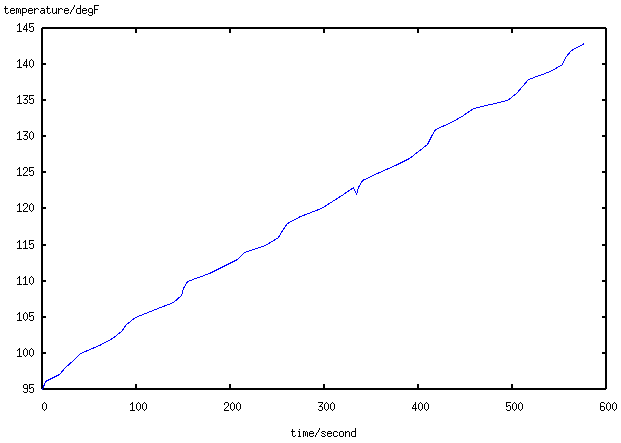
(Plotted using GNU Plot from within Octave.)
Although some people have suggested that separate propane heaters would be more appropriate, we believe that the best way a decon facility can be viable and properly maintained is if it has a concomitant day-to-day use, e.g. as a shower facility as well.
Thus we invented the "dual use" daily showering system that doubles as a decon facility when needed.
For this reason, the AO Smith product was chosen in favour of propane heaters. This means, simply, that during day-to-day use it runs off natural gas from the city, and during emergencies it would run off stored natural gas.
The other issue is one of electric dependency. While some concerns were raised regarding the need for electric power as well as gas, it is clear that the AO Smith product uses very little electricity. The electric requirement is the most modest, needing only a single phase 120 Volt AC source. Therefore it can easily be run on backup power, which almost always exists in any emergency situation. Presently we have a 12 volt car battery with power inverter that can provide such single phase power. We are in the process of installing photovoltaics and Modified Darius Rotor wind turbines on the roof, to charge one or more 12 volt batteries to meet such modest power requirements.
Additionally, for nearly all applications, including ordinary day-to-day showering, the AO Smith product seems to be the best choice, given its extremely high efficiency and high capacity. It is rare that the highest capacity system is also the most efficient, but in this situation, it appears that the AO Smith has the highest capacity AND the highest efficiency (efficiency is highest whether used at high or low capacity, e.g. even when used at low usage rates, the AO Smith unit still heats water at a lower cost per gallon than other units).
Christmas day, when the building was empty, and certainly nobody would be needing hot water, I switched on the hot water heater, and collected time versus temperature data:
time/min:sec temperature/degF 0:00 095 0:04 096 0:19 097 0:25 098 0:33 099 0:41 100 1:01 101 1:15 102 1:24 103 1:30 104 1:39 105 2:00 106 2:20 107 2:28 108 2:30 109 2:35 110 2:58 111 3:13 112 3:28 113 3:35 114 3:57 115 4:11 116 4:15 117 4:21 118 4:35 119 4:57 120 5:09 121 5:20 122 5:31 123 5:34 122 5:36 123 5:41 124 5:59 125 6:16 126 6:30 127 6:40 128 6:50 129 6:54 130 6:58 131 7:15 132 7:28 133 7:38 134 8:14 135 8:24 136 8:31 137 8:37 138 9:00 139 9:13 140 9:16 141 9:23 142 9:36 143
Plotting the temperature as a function of time gives the following graph:

(Plotted using GNU Plot from within Octave.)
Linear regression gives a slope of 0.080464 degrees F per second, which is 4.8278 degrees F per minute.
1 BTU is 1 pound 1 degree.
There are 10 pounds in a gallon, and the tank is 130 gallons, so the tank holds 1300 pounds of water that is being raised 4.8278 deg F/minute, 4.8278*60*1300BTU/hour = 376,570 BTU/hour (more than the rated 300 BTU/h).
To put this into perspective, if we have 52 deg F water (the temperature
it's coming out of the ground), and want a 105F shower, we mix hot and cold,
but that's equiv. to running the hot water heater up to 105F only, so it's
105-52 = 53 deg F difference,
53deg/4.8278deg/minute = 10.978 minutes to heat the whole tank,
e.g. therefore produces
11.842 gallons per minute, therefore we get approximately enough to run
for or five showers for an infinitely long duration without ever running out of
hot water.
If we assumed a one-third duty cycle (e.g. equal time for showerees to strip, to wash, and to dry off and dress), we would have capacity for 14 showers (e.g. 7 for men, and 7 for women), that could be used to continually shower an infinite number of people.
The tank of course serves as a "buffer", so, for example, it can run our firehose through our Navigator (TM) regulator (25GPM throughput) for just over 5 minutes on a full tank if at 105F but if at higher temperature, it stores more energy, and can then run the firehose for longer and still recover, but the steady-state conditions are the same (e.g. the firehose can run at an average duty cycle of 50 percent).
Another interesting question: what's the cost (dollars per minute) to keep the firehose running with 105 deg F water?
A full tank to be warmed to showering temperature (or equivalently that portion of a tank that would be used for showering temperature if mixed from a higher temperature) costs therefore 53.022 cents.
Cold water costs approx. 1.2317$/cubic meter approx. .4662491960 cents per gallon, e.g. approx. 61 cents for a full (130 gallon) tank.
Thus the true cost to decon someone with the full tank is approximately one dollar and fourteen cents, but of course it is unlikely that an entire tank full of water would be needed to decon each person. It is more likely that it would cost only a few cents per person.
(Another site lists water as $7.79 per thousand gallons = .779 cents per gallon.)
Similar calculations were performed on an older BTH 199 unit.